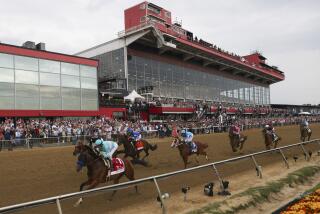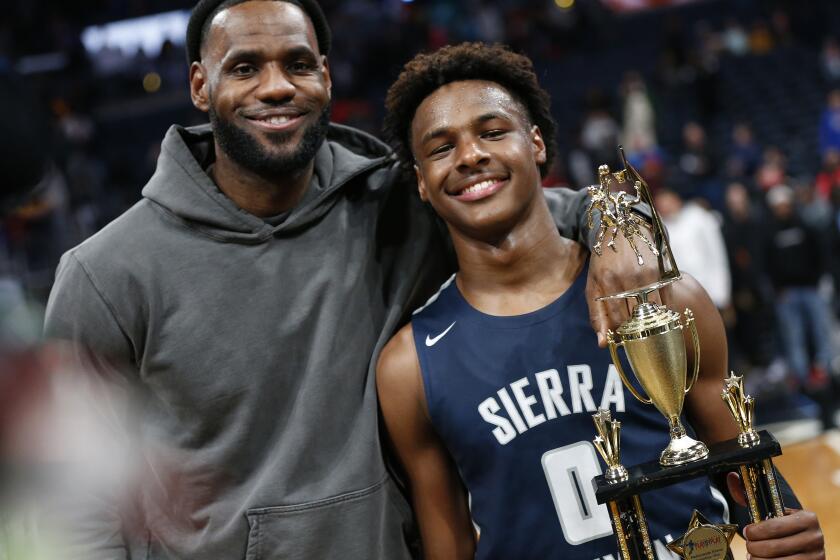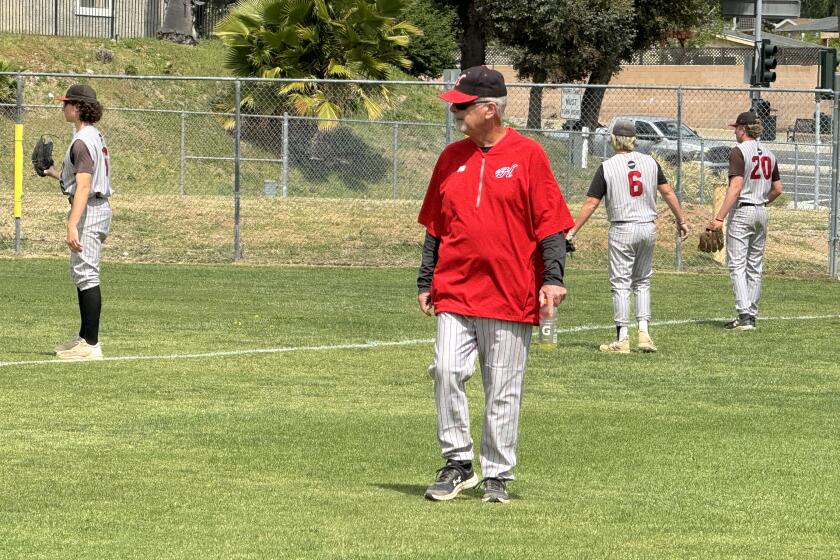Lions’ Fontes Converts to the Gospel of Gibbs
One of the higher compliments ever paid by one coach to another was Frank Leahy’s, when, in his second season at South Bend in 1942, he put the Notre Dame football team in Clark Shaughnessy’s man-in-motion T-formation.
Only the year before, Leahy had taken the Fighting Irish to No. 3 in the national polls in an entirely different system--a single-wing formation called the Notre Dame box.
Half a century later, a similar compliment has been made by Detroit Lion Coach Wayne Fontes.
The most successful of the NFL’s three run-and-shoot coaches last year, Fontes, who led Detroit to a 12-4 record, has chosen a different offense for next season.
He has switched to Joe Gibbs’ Washington Redskin system, a one-back, or ace, formation that Gibbs has used to win three of the last 10 Super Bowls.
Fontes, underlining his resolve, has brought in a new offensive coordinator, Gibbs protege Dan Henning, who was coach of the San Diego Chargers last year.
“If Wayne was interested in the run-and-shoot now, he’d still have (former assistant) Mouse Davis,” Henning told Detroit writers.
Said Fontes: “What the Redskins do, that’s what I’m looking for.”
What the Redskins do defines them. They differ from other teams--even other ace-formation teams--in what they do before the snap, as well as after.
Their fundamentals:
--Before the snap, the Redskins jump around in a highly complex movement scheme.
--They alter formations continually--as many as seven times in one play--by shifting tight ends from place to place and putting wide receivers in motion.
“(Their) formations confuse you,” Denver Coach Dan Reeves said. “You never know which it’ll be, run or pass.”
Precisely.
Said Sid Gillman, former NFL coach: “If you’re a defensive back on the other side, your assignment will change four or five times in the blink of an eye. You’re trying to remember your assignment after the third (shift), when here comes another.”
After the snap, as Fontes has learned firsthand, the Redskins attack with the simplest offensive design in football, college or pro:
--Gibbs basically calls only three plays--a power run, a counter play or a long pass.
--All three are in the Redskins’ offensive mix in every game, and they run them out of every formation.
--Thus at each snap, regardless of whether they are combining bunches of tight ends or wide receivers, the Redskins threaten power, counter and bomb.
Opponents who overload in any of those areas are particularly vulnerable in the others. They also are more vulnerable if the Redskins surprise them with an occasional short pass, draw play or end run.
Besides all that, Gibbs’ long-pass tactics change each week. A Redskin wide receiver doesn’t simply sprint deep and run under the ball. Instead, regardless of the formation in which he lines up, he capitalizes on specific defensive dispositions.
“The surprise is that Gibbs has only won three Super Bowls,” Gillman said.
That might not be a surprise to Gibbs, though, because, as opponents have often noted, he has rarely had a championship quarterback.
Joe Theismann and Doug Williams were nearing the end of careers in the 1980s when Gibbs, with first one and then the other at quarterback, coached the Redskins to their first two NFL titles.
Mark Rypien is different. The most valuable player of Super Bowl XXVI, in which Washington defeated the Buffalo Bills, 37-24, Rypien is the first robust, skilled, young quarterback Gibbs has had.
Rypien, 29, has proven to be what the Redskins needed most: an ideal game-day interpreter of Gibbs’ strategy of offense.
What this suggests is that the Redskins have come up with what might be the NFL’s team of the ‘90s.
What remains to be seen is whether the Lions will be as effective in Gibbs’ offense as they were in Mouse Davis’ offense.
A COACHES’ GAME
That football can be played in extraordinarily different ways is what sets it apart. Unlike many other pastimes, it is essentially a coaches’ game.
It follows that imagination and innovation pay off in football. And in recent years, two NFL leaders have made those particular qualities pay off the most.
They are Bill Walsh, now at Stanford, who coached the 1979-88 San Francisco 49ers, and Gibbs, who has been with the Redskins since 1981.
Although some coaches say that football is merely blocking, tackling and turnovers, Walsh and Gibbs seem to have proven otherwise with their subtly conceived offensive systems--different but similarly effective.
Along the way, their conference, the NFC, has won 10 of the last 11 Super Bowls; therefore, it is commonly believed that the NFC has been dominating the AFC.
But that isn’t quite the case. Actually, it is Walsh and Gibbs who have dominated both conferences.
The numbers:
--Gibbs, a leader of the league’s 1990s offensive evolution, has coached three Super Bowl winners in four appearances for Washington.
--Walsh, a leader of the NFL’s 1980s evolution, built four Super Bowl winners for San Francisco.
Walsh coached the 49ers to their third championship in 1989, then resigned, and a year later they won No. 4 with Walsh’s organization, his offensive strategy, his defensive approach, his coaching staff--led by George Seifert--and his players, notably Joe Montana and Ronnie Lott.
That’s seven of the last 11 Super Bowls for Walsh-Gibbs teams.
It is no more than an accident of history, however, that in those 11 games, the AFC lost so often. Walsh and Gibbs have their roots in the AFC--the historically more-imaginative conference.
Gibbs began as a protege of a celebrated innovator, Don Coryell, the 1978-86 Air Coryell coach of the San Diego Chargers. He worked with Coryell for a decade as player and assistant.
Walsh spent 10 seasons as an AFC coach--eight under Paul Brown at Cincinnati, one with Al Davis and the Raiders and one under Coryell at San Diego--in a conference that grew from the old AFL in the same sense that the NFC developed out of the old NFL.
Walsh and Gibbs are traditional, pass-minded AFC types.
And although it is obvious that Walsh and Gibbs also are united in their deep respect for the football basics--aggressive defense and offensive power among them--it is their offensive flair that distinguishes both.
DIFFERENT WAYS TO THE TOP
Only two other NFC teams have won Super Bowls in the ‘80s and ‘90s: the New York Giants under Bill Parcells (two) and the Chicago Bears under Mike Ditka--the AFC Raiders won twice, in 1981 and 1984. And the conspicuous thing about those NFC results is that they have been singularly influential:
--The Bears and Giants are both physical teams whose behavior appeals to the NFL’s numerous conservatives.
--Both organizations and their admirers talk about it a lot.
--That leads many fans to conclude that the NFC has physically manhandled the AFC for 11 years.
But has it?
Examined closely, that seems to be mostly a myth. For it is obvious, first of all, that in a game as rough as pro football, any one team is likely to be about as tough as another.
Second, despite the NFC’s many recent NFL champions, the NFC hasn’t benefited from any trickle-down effect. Except at the top, the two conferences have been competitive in the 22 regular seasons since the 1970 merger. The AFC has won 513 games, the NFC 475.
Last year’s series was won by the NFC, 33-19, but the year before they were even, 26-26. And through the 1980s, when the NFC was piling up Super Bowl titles, AFC teams usually finished the regular season in a tie with the NFC or ahead.
The difference between the conferences, for the last 11 years, has been reflected only on Super Bowl Sundays.
And in a coaches’ sport, most of the difference, demonstrably, has been made by Walsh andGibbs.
Here is how they have individually used the power of the creative impulse to achieve consistent success by different means:
Philosophy:
Gibbs prefers to attack with big-play passes integrated with simple power running in single-back formations.
Walsh prefers short, ball-control passes integrated with a variety of complex running plays by two backs.
Personnel:
Gibbs changes the lineup on almost every play, varying from three wide receivers or more to three tight ends or more, even to three backs.
Walsh tends to leave the same lineup on the field. In the pure Walsh system, there are always two backs, two wide receivers and a tight end, even on the goal line, even in the two-minute drill.
Execution:
Gibbs uses a minimum number of plays in a maximum number of formations. Reasoning that it takes longer to polish plays than formations, he is able to get the practice-week repetitions that make his handful of plays so mistake-free.
Walsh, taking an opposite tack, uses a lot of different plays in a few formations. The genius is in the details, the philosophers say, and thus the 49ers in Walsh’s day had more plays than perhaps any other team in football history. In particularly creative stretches, he sometimes designed a new package of plays for every opponent.
Procedure:
The one thing that Walsh and Gibbs most plainly have in common, the thing that separates them from most other coaches, is their dedication to a consistent game-day integration of running plays and pass plays.
Walsh does it by routinely calling the number of every back and receiver in his lineup. Gibbs does it by routinely calling every play in every game plan.
As offensive strategists, many coaches tend to stick with what’s working: the running game, they usually hope.
This year, Walsh, as a former college coach turned pro coach turned college coach again, is starting down a new path. And in pro ball, that leaves Gibbs and his Washington players unchallenged.
Unless the Redskins trip on their new run-and-shoot.
More to Read
Get our high school sports newsletter
Prep Rally is devoted to the SoCal high school sports experience, bringing you scores, stories and a behind-the-scenes look at what makes prep sports so popular.
You may occasionally receive promotional content from the Los Angeles Times.






